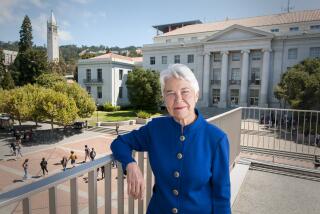UCI Sees Saving Bird as Natural Thing to Do : Environment: University changes its construction plans to allow gnatcatcher an encore performance.
- Share via
IRVINE — In an effort to save rare songbirds, UC Irvine has devised a plan that changes the location of a planned chancellor’s residence and permanently preserves all sensitive habitat on campus, university officials said Wednesday.
The university had planned to build the University House, estimated to cost $3 million, atop a bluff that contains coastal sage scrub. The vanishing mix of brush and grasses is home to gnatcatchers, a threatened species of tiny gray and black birds.
UCI’s new plan moves the house 60 feet and its access road 300 feet to the north of the rare habitat. Under the revision, the site will be preserved and fenced off as part of a 70-acre ecological reserve that will contain all of the birds’ nesting grounds surrounded by a 100-foot buffer.
“The site now shrinks back from the territory where the gnatcatcher is,” said Timothy Bradley, an ecology professor who is chairman of the UCI faculty’s land-use and environment committee. “It is on the periphery of the previous site, and it has all the same beautiful aspects while still protecting the biological resources.”
Biology professors and other faculty members and student groups pressured the Administration to change the site because they said the university would be setting a poor example if it endangered the rare bird.
The faculty land-use committee voted 7 to 3 to approve the plan, which next must be considered by the faculty’s executive committee in mid-January. Approval is expected, and construction on the house is expected to begin next spring.
Bradley said he is particularly pleased that the university’s revised plan protects all coastal sage scrub on the campus.
Coastal sage scrub, which lines canyons in coastal areas of Southern California, is one of the region’s most threatened habitats. It feeds and shelters a wide variety of native species.
The gnatcatcher is so rare that it is expected to be added soon to the federal list of endangered species. Biologists say its plight is a sign that the entire ecosystem in Orange County’s coastal canyons has been disrupted and endangered.
“The new plan deals not only with the University House, but all the threats to the gnatcatcher,” Bradley said. “The university has designed an ecological reserve that will defend the gnatcatcher on campus. It will be protected and fenced and designated with signs. This is a very big step.”
The plan came after Bradley and biology professor Richard E. MacMillen called the original site “a biological gem” in a letter to the chancellor and campus planners. A rare nest holding four gnatcatcher chicks was seen on the site a few months ago.
“If there is a message from this, it is perhaps that through careful planning, one can in fact protect large pieces of this habitat and still complete a great deal of development,” Bradley said.
Karen Newell Young, a UCI spokeswoman, said the plan is “still considered preliminary,” but she added that the executive committee probably will approve it.
“The big issue was the parking and entryway, which was closest to the nesting grounds. The big bone of contention was that it was too close,” she said.
An environmental study showed that the original construction would have had “unavoidable adverse impacts” on the wrenlike bird that nests in the shrubs and grasses.
From 70% to 90% of Orange County’s coastal sage scrub already has disappeared. Major new housing developments, including the Irvine Coast community south of UCI, and the county’s plans to build three toll roads could disrupt much of the remaining portion.
The original site was atop a hill with a sweeping view of the campus, Newport Bay and the ocean. The new site is nearby and has the same basic view, but is not as high on the bluff.
The house, funded by private sources, will be the chancellor’s official residence as well as an entertainment facility and guest quarters. UCI is the only university without an on-campus chancellor’s house.
As part of the plan, the university decided not to expand California Avenue through the nesting areas as originally planned and will work to avoid impact from construction of the San Joaquin Transportation Corridor.
UNIVERSITY HOUSE SITE
UCI originally planned to build the chancellor’s residence on habitat used by a rare bird. Because of protests, the planned site for the house has been moved 60 feet north and its access road 300 feet north. The university also plans to preserve all remaining sensitive habitat on the campus in a 70-acre fenced sanctuary.
More to Read
Sign up for Essential California
The most important California stories and recommendations in your inbox every morning.
You may occasionally receive promotional content from the Los Angeles Times.










